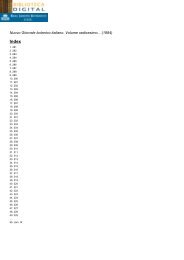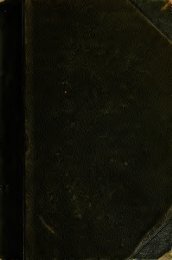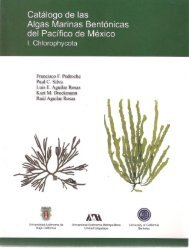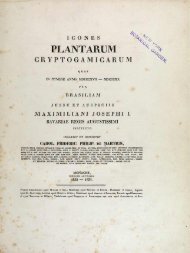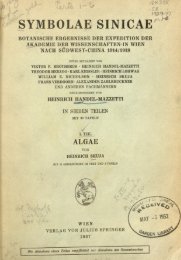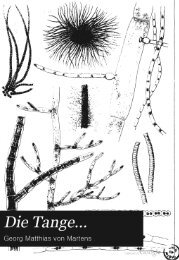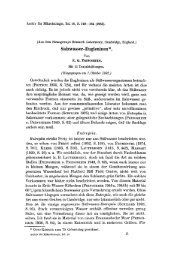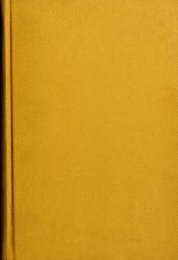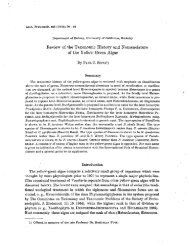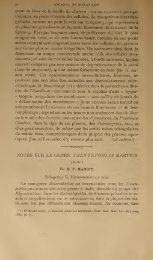Mass cultivation of seaweeds: current aspects and ... - Algaebase
Mass cultivation of seaweeds: current aspects and ... - Algaebase
Mass cultivation of seaweeds: current aspects and ... - Algaebase
Create successful ePaper yourself
Turn your PDF publications into a flip-book with our unique Google optimized e-Paper software.
<strong>Mass</strong> <strong>cultivation</strong> <strong>of</strong> <strong>seaweeds</strong>: <strong>current</strong> <strong>aspects</strong> <strong>and</strong> approaches<br />
Klaus Lüning* <strong>and</strong> Shaojun Pang<br />
Alfred-Wegener-Institut für Polar- und Meeresforschung, Wattenmeerstation Sylt, Hafenstrassse 43, List/Sylt,<br />
25992, Germany; *Author for correspondence (e-mail: kluening@awi-bremerhaven.de; phone:<br />
+49-4651-956-142; fax: +49-4651-956-200)<br />
Received 20 July 2002; accepted in revised form 26 November 2002<br />
Key words: Epiphytes, Integrated <strong>cultivation</strong>, Seaweed <strong>cultivation</strong>, Seaweeds<br />
Abstract<br />
Journal <strong>of</strong> Applied Phycology 15: 115–119, 2003.<br />
© 2003 Kluwer Academic Publishers. Printed in the Netherl<strong>and</strong>s.<br />
A word-wide overview is presented <strong>of</strong> the <strong>current</strong> state <strong>of</strong> mass <strong>cultivation</strong> <strong>of</strong> <strong>seaweeds</strong>. In comparison with a<br />
total annual commercial production <strong>of</strong> fish, crustaceans <strong>and</strong> molluscs <strong>of</strong> about 120 × 10 6 t, <strong>of</strong> which one-third is<br />
produced by aquaculture, the production <strong>of</strong> <strong>seaweeds</strong> is about 10 × 10 6 t wet weight; the majoirty <strong>of</strong> this comes<br />
from culture-based systems. The Top Ten Species List is headed by the kelp Laminaria japonica with 4.2 × 10 6<br />
t fresh weight cultivated mainly in China. The productivity <strong>of</strong> a well-developed, multi-layered, perennial seaweed<br />
vegetation is as high as dense terrestrial vegetation, <strong>and</strong> even higher annual values for productivity have<br />
been reported for tank cultures <strong>of</strong> macroalgae. Epiphytes provide a major problem for the seaweed cultivator, but<br />
can be controlled by growing plants at high densities in rope cultures in the sea, or, more easily, in seaweed tank<br />
cultures on l<strong>and</strong>. The main environmental problem <strong>of</strong> animal (fed) aquaculture is the discharge <strong>of</strong> nutrient loads<br />
into coastal waters, e.g., 35 kg N <strong>and</strong> 7 kg P t −1 aquacultured fish. Integration <strong>of</strong> fish <strong>and</strong> seaweed farming may<br />
help to solve this problem, since <strong>seaweeds</strong> can remove up to 90% <strong>of</strong> the nutrient discharge from an intensive fish<br />
farm. <strong>Mass</strong> culture <strong>of</strong> commercially valuable seaweed species is likely to play an increasingly important role as<br />
a nutrient-removal system to alleviate eutrophication problems due to fed aquaculture.<br />
Introduction<br />
Marine macroalgae form dense st<strong>and</strong>s on the well-illuminated<br />
rocky margin <strong>of</strong> all continents <strong>and</strong> the productivity<br />
<strong>of</strong> a well-developed, multi-layered, perennial<br />
seaweed bed is as high as a dense forest or a<br />
man-made microalgal culture (Lüning 1990). It is<br />
therefore no wonder that <strong>seaweeds</strong> have been utilised<br />
<strong>and</strong> farmed by man for hundreds <strong>of</strong> years as food <strong>and</strong><br />
fodder, particularly in the Far East. What are the <strong>current</strong><br />
goals, problems <strong>and</strong> approaches in seaweed <strong>cultivation</strong>?<br />
Global utilization <strong>of</strong> <strong>seaweeds</strong> for food, fodder,<br />
chemicals <strong>and</strong> pharmaceuticals is on the increase<br />
<strong>and</strong>, in terms <strong>of</strong> harvested biomass per year, <strong>seaweeds</strong><br />
are among the most important cultivated marine organisms,<br />
as will be discussed below.<br />
115<br />
Top ten cultured species <strong>and</strong> trends in worldwide<br />
seaweed production<br />
The present world production <strong>of</strong> fish, crustaceans <strong>and</strong><br />
molluscs is approximately 120 × 10 6 t, <strong>and</strong> about one<br />
third <strong>of</strong> this is produced by aquaculture (FAO 2001).<br />
In addition, approximately 10 × 10 6 t seaweed (fresh<br />
weight) are produced, the largest part <strong>of</strong> which comes<br />
from culture-based practices (FAO 2001). The Top<br />
Ten Species List for aquaculture production is headed<br />
by the kelp Laminaria japonica with 4.2 × 10 6 t, cultivated<br />
mainly in China, followed by the Pacific oyster<br />
Crassostrea gigas with 2.9 × 10 6 t (FAO 2001).<br />
Commercial farming <strong>of</strong> seaweed has a long history.<br />
At present there are approximately 200 species<br />
<strong>of</strong> <strong>seaweeds</strong> used worldwide (Zemke-White <strong>and</strong><br />
Ohno 1999), <strong>of</strong> which about 10 species or genera are<br />
intensively cultivated, such as the brown algae Laminaria<br />
japonica <strong>and</strong> Undaria pinnatifida, the red algae<br />
Porphyra, Eucheuma, Kappaphycus <strong>and</strong> Gracilaria
116<br />
Table 1. Seaweed production (t fresh weight) in three Asian countries<br />
<strong>and</strong> a few examples from other countries in 1999 (FAO 2001)<br />
Brown algae Red algae Green algae<br />
World production 5987490 1974110 71779<br />
China 4474090 426733 47<br />
Japan 231443 413057 313<br />
Korea 270717 208610 6447<br />
Philippines – 617715 3538<br />
USA 7955 81 –<br />
Norway 17892 – –<br />
France 6939 2492 119<br />
Spain 28 14790 –<br />
Portugal – 1949 –<br />
<strong>and</strong> the green algae Monostroma <strong>and</strong> Enteromorpha<br />
(Wikfors <strong>and</strong> Ohno 2001). An increasing number <strong>of</strong><br />
people are becoming aware <strong>of</strong> the benefits <strong>and</strong> potential<br />
<strong>of</strong> macroalgae <strong>and</strong> new algal products <strong>and</strong> novel<br />
uses <strong>of</strong> <strong>seaweeds</strong> are acting as a stimulant to encourage<br />
more research <strong>and</strong> development <strong>of</strong> seaweed <strong>cultivation</strong>.<br />
At present, the main areas, where <strong>seaweeds</strong><br />
are cultured are concentrated in eastern Asia where<br />
eating algae has been commonplace for thous<strong>and</strong>s <strong>of</strong><br />
years (Table 1).<br />
Productivity in the natural environment <strong>and</strong><br />
mass culture<br />
In the natural environment, values for maximum productivity<br />
are 10 times higher for a seaweed st<strong>and</strong> than<br />
for a plankton population which is due to the fixed<br />
position <strong>of</strong> a seaweed on a substrate (Lüning 1990).<br />
This ecological advantage allows macroalgae to form<br />
a stable, multi-layered, perennial vegetation capturing<br />
almost every photon falling on a square metre <strong>of</strong><br />
rocky bottom, as in a dense terrestrial forest, where<br />
almost no light reaches the forest floor. The parameters<br />
for a highly productive ecosystem are the same<br />
on l<strong>and</strong> <strong>and</strong> in the sea, with maximum productivity at<br />
1.8 kg C m −2 yr −1 <strong>and</strong> a maximum chlorophyll content<br />
<strong>of</strong> 3gm −2 ground or illuminated surface. In a<br />
seaweed st<strong>and</strong>, this is achieved with an algal biomass<br />
<strong>of</strong> approximately 10 kg m −2 (Lüning 1990). In contrast,<br />
most <strong>of</strong> the photons falling on a natural planktonic<br />
community are absorbed or scattered by abiotic<br />
particles, because the algae are so thinly distributed.<br />
This results in much lower productivity in a planktonic<br />
community than in a macroalgal st<strong>and</strong>.<br />
Cultivation <strong>of</strong> microalgae involves packing the<br />
cells very densely in a bottle or pond <strong>and</strong> this results<br />
in productivity similar to that in a fixed macroalgal<br />
community. One might say that the rigid walls <strong>of</strong> the<br />
bottle or the pond are as efficient in concentrating a<br />
maximum <strong>of</strong> photosynthetically active cells on a<br />
square meter <strong>of</strong> ground as a rocky shore is as concentrating<br />
the fixed life forms <strong>of</strong> the macrophytes. The<br />
same is valid for tank <strong>cultivation</strong> <strong>of</strong> free-floating <strong>seaweeds</strong>,<br />
with a maximum <strong>of</strong> approximately 10 kg wet<br />
algal biomass per square meter <strong>of</strong> illuminated tank<br />
surface. The tank walls keep this high amount <strong>of</strong> biomass<br />
together, while in the field the free-floating seaweed<br />
biomass would drift away <strong>and</strong> dilute in all directions.<br />
In this way the seaweed cultivator may take<br />
apart the different layers <strong>of</strong> a multi-layered seaweed<br />
community <strong>and</strong> cultivate each <strong>of</strong> the components separately,<br />
free-floating in a tank culture due to air agitation.<br />
Cultivators <strong>of</strong> micro- or macroalgae should thus be<br />
able to reach productivity values, which are at least<br />
as high as, under optimum conditions, in a natural,<br />
highly productive ecosystem. In fact, higher annual<br />
productivity values have been reported in macroalgal<br />
tank cultures, e.g., a mean <strong>of</strong> 39.7 g dry weight m −2<br />
d −1 over the whole experimental period <strong>of</strong> 32 months<br />
in Gracilaria ferox grown continuously in tanks under<br />
a pulse-fed nutrient regime in Key Largo, Florida<br />
(Capo et al. 1999). This productivity is equal to 5.4<br />
kgCm −2 yr −1 , <strong>and</strong> thus three times higher than in a<br />
highly productive ecosystem, taking into account that<br />
25% dry weight is mineral ash <strong>and</strong> 50% <strong>of</strong> the remaining<br />
organic weight is carbon (Lüning 1990). Obvious<br />
reasons for such higher productivity in monoculture<br />
<strong>of</strong> <strong>seaweeds</strong> in outdoor tanks are beneficial<br />
factors such as continuous nutrient supply, absence <strong>of</strong><br />
grazers or minimum disturbance by epiphytes, if<br />
readily achieved by the cultivators.<br />
Epiphytes: a major problem in seaweed<br />
<strong>cultivation</strong> <strong>and</strong> how to control them in tank<br />
culture<br />
It is difficult to control epiphytes when <strong>seaweeds</strong> are<br />
cultured under non-unialgal conditions. As to seaweed<br />
<strong>cultivation</strong> on ropes in the sea, motile<br />
propagules <strong>of</strong> algae <strong>and</strong> animals have free access to<br />
all surfaces <strong>of</strong> the cultivated <strong>seaweeds</strong> <strong>and</strong> there is<br />
plenty <strong>of</strong> underwater light available to encourage the<br />
growth <strong>of</strong> epiphytic algae. Epiphytism <strong>of</strong> <strong>seaweeds</strong> on
opes in the sea or in l<strong>and</strong>-based tanks can be controlled<br />
by growing plants with high densities. This<br />
approach was described for tank <strong>cultivation</strong> in details<br />
by Bidwell et al. in Nova Scotia when they developed<br />
their tank <strong>cultivation</strong> system for Irish moss, Chondrus<br />
crispus (Bidwell et al. 1985). At a density <strong>of</strong> approximately<br />
10 kg wet biomass m −2 <strong>of</strong> tank surface <strong>and</strong> a<br />
tank depth <strong>of</strong> 60–90 cm, there is essentially complete<br />
light absorption by the plant material, <strong>and</strong> the irradiance<br />
near the tank bottom is almost zero. Creation <strong>of</strong><br />
circulating cells <strong>of</strong> water by rising air bubbles from<br />
bottom air pipes was found to be the best method <strong>of</strong><br />
keeping a dense algal biomass in constant motion,<br />
<strong>and</strong> vigorous aeration also ensured exposure <strong>of</strong> plants<br />
to light for a short time every minute. The water circulation<br />
time in the circulating cells was about 1.0 to<br />
1.5 minutes, <strong>and</strong> the algae were alternately exposed<br />
to bright sunlight at the tank surface for about 10<br />
seconds <strong>and</strong> then plunged to the depths <strong>of</strong> the tank<br />
<strong>and</strong> virtual darkness with little or no photosynthesis<br />
during the remaining 50 seconds (Bidwell et al.<br />
1985). In a tank with a surface area <strong>of</strong> 2.6 m 2 <strong>and</strong> a<br />
depth <strong>of</strong> 0.8 m inoculated with Palmaria palmata at<br />
a density <strong>of</strong> 8 kg m −2 we found that the irradiance at<br />
0.5 m depth was 0.05% <strong>of</strong> surface irradiance.<br />
Although growth rate <strong>of</strong> individual plants is lower<br />
in a dense culture, the yield per square metre tank<br />
surface is high, simply because there is so much biomass<br />
in the tank that small increases <strong>of</strong> the individual<br />
thalli add up to an impressive overall yield. In contrast,<br />
germlings <strong>of</strong> algal epiphytes such as species <strong>of</strong><br />
Enteromorpha, Ulva <strong>and</strong> Ectocarpus cannot establish<br />
a substantial biomass in these conditions, because<br />
they are fast-growing, opportunistic organisms <strong>and</strong><br />
require high irradiances (r strategist). As an example,<br />
the mean epiphyte biomass, mainly Giffordia <strong>and</strong> Enteromorpha,<br />
was only 2.7% <strong>of</strong> the biomass <strong>of</strong><br />
Gracilaria ferox in the tank cultures in Key Largo,<br />
Florida (Capo et al. 1999). Perennial <strong>seaweeds</strong> such<br />
as Gracilaria (K strategists) collected from the undergrowth<br />
<strong>of</strong> a multi-layered seaweed community are<br />
guarded against epiphytes by high-density cultures,<br />
which act as a �light umbrella�. In natural populations,<br />
these plants are shielded from excess irradiance <strong>of</strong>ten<br />
by larger algae, e.g., by the kelp canopy.<br />
The method <strong>of</strong> reducing growth <strong>of</strong> epiphytes by<br />
<strong>cultivation</strong> at high densities was first developed by<br />
Ryther et al. (1979) working in <strong>Mass</strong>achusetts <strong>and</strong><br />
Florida, <strong>and</strong> later by Bidwell et al. (1985) working in<br />
Nova Scotia. In the early 1970’s the Ryther group at<br />
Woods Hole, <strong>Mass</strong>achusetts <strong>and</strong> Harbor Branch<br />
117<br />
Foundation, Florida started seaweed <strong>cultivation</strong> by<br />
screening different species <strong>of</strong> <strong>seaweeds</strong> for their<br />
growth potential in raceways <strong>and</strong> tanks. The best<br />
yields, mainly <strong>of</strong> the agarophyte Gracilaria foliifera<br />
<strong>and</strong> the carrageenophyte Neoagardhiella baileyi, were<br />
obtained in full sunlight, at low nutrient concentrations,<br />
with turnover rates <strong>of</strong> at least 20 volumes d −1<br />
<strong>and</strong> at a density <strong>of</strong> 2–4 kg wet weight m −2 <strong>of</strong> tank<br />
surface. That observation led to harvesting by halving<br />
the density <strong>of</strong> cultures from 4 to 2 kg m −2 after<br />
whatever time was needed for such a doubling. Bidwell<br />
et al. cultured Irish moss (Chondrus crispus) at<br />
densities as high as 8–12 kg m −2 (Bidwell et al.<br />
1985). They found that large amounts <strong>of</strong> plant material<br />
can be held in reserve in small tanks for up to 6<br />
weeks in summer at density <strong>of</strong> 20 kg m −2 <strong>and</strong> with<br />
very low level <strong>of</strong> aeration without any sign <strong>of</strong> deterioration,<br />
epiphyte infestation or disease. Returning<br />
plants to normal <strong>cultivation</strong> conditions started growth<br />
at the expected rate.<br />
A second method <strong>of</strong> reducing epiphytism is more<br />
recent <strong>and</strong> may be described as meristem activation<br />
by short-day treatment in summer. In laminarian species<br />
it had been found that the seasonal growth<br />
rhythm (with fast growth in winter <strong>and</strong> spring <strong>and</strong><br />
growth reduction in summer) is controlled by endogenous,<br />
circannual rhythmicity <strong>and</strong> is synchronised by<br />
the annual course <strong>of</strong> daylength, with short days in<br />
early winter starting the new growth (Lüning 1993).<br />
Treatment with continuous short days in the laboratory<br />
acts as a strong, environmental zeitgeber signal<br />
<strong>and</strong> results in continuous activation <strong>of</strong> the basal blade<br />
meristem <strong>and</strong> continuous growth throughout the year.<br />
In other words, the normal seasonal sequence <strong>of</strong><br />
growth-on <strong>and</strong> growth-<strong>of</strong>f is interrupted <strong>and</strong> turned<br />
into arrhythmic, continuous growth. When Laminaria<br />
digitata was cultured in outdoor cultures with automatic<br />
blinds allowing 8 hours <strong>of</strong> light per day in summer,<br />
continued high growth activity throughout the<br />
summer was observed (Gomez <strong>and</strong> Lüning 2001). In<br />
a control tank at ambient daylength, growth rate was<br />
down-regulated due to the annual course <strong>of</strong> daylength<br />
as a zeitgeber. Continuous growth activity in summer<br />
would counteract the natural reduction <strong>of</strong> growth rate<br />
in summer in perennial algae <strong>and</strong> may help to reduce<br />
or prevent growth <strong>of</strong> epiphytes. Several commercially<br />
valuable perennial red algae are <strong>current</strong>ly being tested<br />
in this respect as part <strong>of</strong> the EU project SEAPURA<br />
which aims to develop <strong>cultivation</strong> techniques for red<br />
algae, not used before in integrated culture with fish.
118<br />
Seasonality problems <strong>and</strong> the perennial seaweed<br />
life form<br />
Another ecological advantage in many seaweed species<br />
is their perennial life form, with a potential life<br />
span <strong>of</strong> up to 15 years in certain Laminaria species.<br />
At mid- <strong>and</strong> high latitudes, storage <strong>of</strong> carbohydrates<br />
in summer in the perennial thallus portions allows<br />
growth to start in winter <strong>and</strong> thus a strategy <strong>of</strong> �early<br />
nutrient scrubbing�. Growth <strong>of</strong> the new year’s thallus<br />
portions in a perennial seaweed starts from December/January<br />
onwards, even when underwater irradiance<br />
is low. In this way perennial <strong>seaweeds</strong> exploit<br />
the high levels <strong>of</strong> nutrients in seawater during winter<br />
using stored carbohydrates as sources <strong>of</strong> energy <strong>and</strong><br />
building material for the new parts <strong>of</strong> the thallus. In<br />
contrast, planktonic algae have to wait for the light to<br />
increase in early spring to start the spring bloom.<br />
However, longevity <strong>of</strong> the perennial life form <strong>of</strong> a<br />
seaweed has two disadvantages, both important for<br />
the cultivator, because it facilitates <strong>and</strong>/or encourages<br />
the growth <strong>of</strong> epiphytes. Firstly, the perennial thallus<br />
is an ideal substrate for many pelagic <strong>and</strong> benthic<br />
plant <strong>and</strong> animal cells. These epiphytes reduce or<br />
eliminate the supply <strong>of</strong> irradiance, carbon <strong>and</strong> nutrients<br />
to the surface cells <strong>of</strong> the perennial seaweed <strong>and</strong><br />
therefore reduce the productivity <strong>of</strong> the basiphyte.<br />
The perennial seaweed has developed several strategies<br />
to reduce this danger, firstly by producing the<br />
first cells <strong>of</strong> the new year’s thallus portions in early<br />
winter from reserve materials when low underwater<br />
irradiance makes life difficult also for epiphytic microalgae<br />
such as benthic diatoms. In addition to this,<br />
antibiotic substances may guard the young, newly<br />
grown thallus portions, while the old portions are<br />
used for supporting growth <strong>of</strong> the young thallus portions<br />
by translocation <strong>of</strong> organic substances <strong>and</strong> minerals<br />
<strong>and</strong> also for production <strong>of</strong> sporangia <strong>and</strong> gametangia.<br />
Spores <strong>and</strong> gametes <strong>of</strong> the perennial seaweed<br />
are released from the heavily overgrown old thallus<br />
portions into the water. Thereafter, the old portions<br />
may eventually be cast <strong>of</strong>f as a useless portion <strong>of</strong> the<br />
perennial algal thallus, also taking with them all the<br />
epiphytes whose original �intention� had been to find<br />
a place for life as safe as a piece <strong>of</strong> rock.<br />
A second disadvantage <strong>of</strong> longevity in a perennial<br />
seaweed at mid- <strong>and</strong> high latitudes is the necessary<br />
reduction <strong>of</strong> growth rate in summer, even in the presence<br />
<strong>of</strong> sufficient nutrients (Lüning 1979). Since the<br />
bulk <strong>of</strong> photosynthate produced in summer has to be<br />
stored as carbohydrate to be used in winter for sur-<br />
vival <strong>of</strong> the remaining perennial thallus <strong>and</strong> production<br />
<strong>of</strong> the first new thallus portions, growth rate must<br />
be reduced in summer. This process is controlled <strong>and</strong><br />
synchronised by the long-day signal in laminarian<br />
species (Lüning 1993). The reduction <strong>of</strong> growth rate<br />
in summer in a perennial alga may result in epiphytism<br />
by animal <strong>and</strong> other algal cells.<br />
Integrated <strong>cultivation</strong>: <strong>seaweeds</strong> as bi<strong>of</strong>ilters for<br />
the fed aquaculture <strong>of</strong> finfish<br />
Fed aquaculture (animal culture) is a booming industry,<br />
but it discharges heavy nutrient loads into coastal<br />
waters, e.g., 35 kg N <strong>and</strong> 7 kg P t −1 aquacultured fish<br />
(Chopin et al. 2001). A possible solution to this problem<br />
is to integrate <strong>seaweeds</strong> into fish farming, in other<br />
words, to combine fed aquaculture with extracting<br />
aquaculture (seaweed culture). Numerous studies<br />
have been performed which combine seaweed culture<br />
with l<strong>and</strong>-based fish tanks or open sea fish cages (e.g.,<br />
Buschmann et al. (2001), Troell et al. (1999), Chopin<br />
et al. (1999, 2001), Neori et al. (2000) <strong>and</strong> Hernández<br />
et al. (2002)). Seaweeds removed up to 90% <strong>of</strong><br />
the nutrients discharged from an intensive fish farm<br />
(Neori et al. 1996). Algal farming along the coasts,<br />
therefore, may function as an effective bi<strong>of</strong>ilter to alleviate<br />
the eutrophication problem worldwide. Another<br />
relevant issue to integrate <strong>seaweeds</strong> into fish<br />
farming year around is to alternate cultivated seaweed<br />
species with seasons. This means a comprehensive<br />
search is required to find seaweed species suitable for<br />
year-round <strong>cultivation</strong> <strong>and</strong> have economic uses in<br />
both l<strong>and</strong>-based <strong>and</strong> open sea <strong>cultivation</strong> systems.<br />
References<br />
Ask E.I. <strong>and</strong> Azanza R.V. 2002. Advances in <strong>cultivation</strong> technology<br />
<strong>of</strong> commercial eucheumatoid species: a review with suggestions<br />
for future reseach. Aquaculture 206: 257–277.<br />
Bidwell R.G.S., McLachlan J. <strong>and</strong> Lloyd N.D.H. 1985. Tank <strong>cultivation</strong><br />
<strong>of</strong> Irish Moss, Chondrus crispus. Bot. Mar. 28: 87–97.<br />
Buschmann A.H., Troell M. <strong>and</strong> Kautsky N. 2001. Integrated algal<br />
farming: a review. Cah. Biol. Mar. 42: 83–90.<br />
Chopin T., Buschmann A.H., Halling C., Troell M., Kautsky N.,<br />
Neori A. et al. 2001. Integrating <strong>seaweeds</strong> into marine aquaculture<br />
systems: a key toward sustainability. J. Phycol. 37: 975–<br />
986.
Chopin T., Yarish C., Wilkes R., Belyea E., Lu S. <strong>and</strong> Mathieson<br />
A. 1999. Developing Porphyra/Salmon integrated aquaculture<br />
for bioremediation <strong>and</strong> diversification <strong>of</strong> the aquaculture industry.<br />
J. appl. Phycol. 11: 463–472.<br />
Capo T.R., Jaramillo J.C., Boyd A.E., Lapointe B.E. <strong>and</strong> Serafy J.E.<br />
1999. Sustained high yields <strong>of</strong> Gracilaria (Rhodophyta) grown<br />
in intensive large-scale culture. J. appl. Phycol. 11: 143–147.<br />
FAO 2001. The state <strong>of</strong> world fisheries <strong>and</strong> aquaculture 2000, Electronic<br />
edition http://fao.org.<br />
Gomez I. <strong>and</strong> Lüning K. 2001. Constant short-day treatment <strong>of</strong><br />
outdoor-cultivated Laminaria digitata prevents summer drop in<br />
growth rate. Eur. J. Phycol. 36: 391–395.<br />
Hernández I., Martínez-Aragón J.F., Tovar A., Pérez-Lloréns J.L.<br />
<strong>and</strong> Vergara J.J. 2002. Bi<strong>of</strong>iltering efficiency in removal <strong>of</strong> dissolved<br />
nutrients by three species <strong>of</strong> estuarine macroalgae cultivated<br />
with sea bass (Dicentrarchus labrax) waste waters 2.<br />
Ammonium. J. appl. Phycol. 14: 375–384.<br />
Kain J.M. 1979. A view <strong>of</strong> the genus Laminaria. Oceanogr. Mar.<br />
Biol. Ann. Rev. 17: 101–161.<br />
Lüning K. 1979. Growth strategies <strong>of</strong> three Laminaria species<br />
(Phaeophyceae) inhabiting different depth zones in the sublittoral<br />
region <strong>of</strong> Helgol<strong>and</strong> (North Sea). Mar. Ecol. Progr. Ser. 1:<br />
195–207.<br />
119<br />
Lüning K. 1990. Seaweeds. Their Environment, Biogeography, <strong>and</strong><br />
Ecophysiology. Wiley, New York, 527 pp.<br />
Lüning K. 1993. Environmental <strong>and</strong> internal control <strong>of</strong> seasonal<br />
growth in <strong>seaweeds</strong>. Hydrobiologia 260/261: 1–14.<br />
Neori A., Krom M.D., Ellner S.P., Boyd C.E., Popper D., Rabinovich<br />
R. et al. 1996. Seaweed bi<strong>of</strong>ilters as regulators <strong>of</strong> water<br />
quality in integrated fish-seaweed culture units. Aquaculture<br />
141: 183–199.<br />
Neori A., Shpigel M. <strong>and</strong> Ben-Ezra D. 2000. A sustainable integrated<br />
system for culture <strong>of</strong> fish, seaweed <strong>and</strong> abalone. Aquaculture<br />
186: 279–291.<br />
Ryther J.H., DeBoer J.A. <strong>and</strong> Lapointe B.E. 1979. Cultivation <strong>of</strong><br />
<strong>seaweeds</strong> for hydrocolloids, waste treatment <strong>and</strong> biomass for<br />
energy conversion. Proc. Int. Seaweed Symp. 9: 1–16.<br />
Troell M., Rönnbeck P., Halling C., Kautsky N. <strong>and</strong> Buschmann<br />
A. 1999. Ecological engineering in aquaculture: use <strong>of</strong> <strong>seaweeds</strong><br />
for removing nutrients from intensive mariculture. J.<br />
appl. Phycol. 11: 89–97.<br />
Wikfors G.H. <strong>and</strong> Ohno M. 2001. Impact <strong>of</strong> algal research in aquaculture.<br />
J. Phycol. 37: 968–974.<br />
Zemke-White W.L. <strong>and</strong> Ohno M. 1999. World seaweed utilisation:<br />
An end-<strong>of</strong>-century summary. J. appl. Phycol. 11: 369–376.



